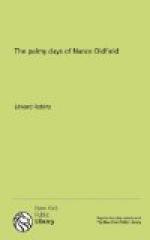How fondly do we turn the pages of the well-read essays, with their pictures of good Sir Roger de Coverley, Will Honeycomb, and the rest of that happy crew. And over what portrait do we linger more lovingly than that of the Spectator himself, wherein there is many a stroke of the pen that brings Addison in view. When he tells us, for instance: “I threw away my rattle before I was two months old, and would not make use of my coral until they had taken away the bells from it,” the writer is indulging in a pretty bit of humour at the expense of his own sedate youth.
* * * * *
“I have passed my latter years,” the philosopher goes on to say, “in this city (London), where I am frequently seen in most public places, though there are not above half a dozen of my select friends that know me.... There is no place of general resort wherein I do not often make my appearance: sometimes I am seen thrusting my head into a round of politicians at Will’s,[A] and listening with great attention to the narratives that are made in those little circular audiences; sometimes I smoke a pipe at Child’s,[B] and while I seem attentive to nothing but the postman, overhear the conversation of every table in the room. I appear on Sunday nights at St. James’ coffee house, and sometimes join the little committee of politics in the inner room, as one who comes there to hear and improve. My face is likewise very well known at the Grecian, the Cocoa Tree, and in the theatres both of Drury Lane and the Haymarket. I have been taken for a merchant upon the Exchange for above these ten years, and sometimes pass for a Jew in the assembly of stockbrokers at Jonathan’s. In short, wherever I see a cluster of people, I always mix with them, though I never open my lips but in my own club.”
[Footnote A: Will’s and Child’s were popular coffee-houses, as were also the Grecian, St. James’, and the Cocoa Tree.]
[Footnote B: See footnote on page 97.]
* * * * *
It is easy to fancy Addison, shy but ever observant, mingling with the people who thronged the coffee-houses and there settled the affairs of the nation, discussed their neighbours, and sipped their coffee or stronger drink, as the case might be. He must have laughed in his sleeve many a time as he heard the know-it-alls predicting that the British nation was on the brink of perdition or announcing, in the most confidential of manners, the secret policies of his Christian Majesty, Louis XIV. of France. Probably Joe agreed with Steele, who, in speaking of a certain coffee-house, observed that in it men differed rather in the time of day wherein they made a figure, than in any real greatness above one another.
[Illustration: JOSEPH ADDISON By SIR GODFREY KNELLER]




